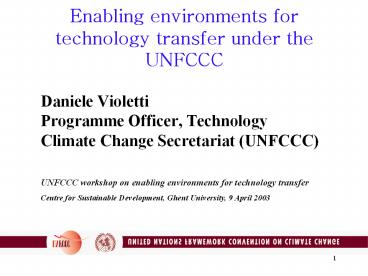Enabling environments for technology transfer under the UNFCCC PowerPoint PPT Presentation
1 / 13
Title: Enabling environments for technology transfer under the UNFCCC
1
Enabling environments for technology transfer
under the UNFCCC
- Daniele Violetti
- Programme Officer, Technology
- Climate Change Secretariat (UNFCCC)
UNFCCC workshop on enabling environments for
technology transfer Centre for Sustainable
Development, Ghent University, 9 April 2003
2
Outline of the Presentation
- Enabling environments in the FCCC process
- Enabling environments in decision 4/CP.7
- Past activities in the FCCC process
- Enabling environments in the National
Communications of Annex II Parties - The EGTT Programme of work
3
Enabling environments in the FCCC process
- SBSTA 5 took note of a list of topics that could
be addressed by the secretariat in a series of
papers. These included activities undertaken by
governments to facilitate the introduction and
use of ESTs (FCCC/SB/1997/1) - Decision 9/CP.3 requested the secretariat to
consider specific case studies,with the aim of
evaluating barriers to the introduction and
implementation of ESTs. - Decision 4/CP.4 requested the Chairman of SBSTA
to establish a consultative processto achieve
agreement on a framework for meaningful and
effective actions to enhance implementation of
Article 4.5 of the Convention.
4
Enabling environments in the FCCC process
- Three regional workshops (Tanzania, Philippines,
El Salvador), provided bottom-up contributions
and set the basis for the Technology framework. - Decision 4/CP.7 included enabling environments
among the key themes of the technology transfer
framework. - SBSTA 16 approved the EGTT programme of work for
the years 2002/2003 including activities on
enabling environments. - SBSTA 17 requested the secretariat to prepare a
technical paper on enabling environments for
technology transfer.
5
Enabling environments in decision 4/CP.7
Definition The enabling environments component of
the framework focuses on government actions, such
as fair trade policies, removal of technical,
legal and administrative barriers to technology
transfer, to technology transfer, sound economic
policy, regulatory frameworks and transparency
all of which create an environment conducive to
private and public sector technology
transfer. Purpose To improve the effectiveness of
the transfer of environmentally sound
technologies by identifying and analyzing ways of
facilitating the transfer of environmentally
sound technologies, including the identification
and removal of barriers at each stage of the
process.
6
Results of the survey of experiences, needs and
opportunities (FCCC/SBSTA/1998/INF.5)
- In 1997 the secretariat with the cooperation of
the UoA conducted a survey requesting non-Annex I
and EITs Parties to provide details on measures
adopted by their governments to facilitate the
transfer and implementation of ESTs, a few
categories were identified - Creating awareness (31 Parties)
- Disseminating information (19 Parties)
- Providing technical assistance (10 Parties)
- Creating a fiscal environment (7 Parties)
- Removing trade barriers (5 Parties)
7
Results of the survey of experiences, needs and
opportunities (FCCC/SBSTA/1998/INF.5)
- In the same survey Parties were requested to
list, based on past experiences, the barriers
encountered in formulating and implementing
technology transfer projects. A few categories
were identified - Financial (7 Parties)
- Economic (4 Parties)
- Technological (4 Parties)
- Institutional (5 Parties)
- Cultural (1 Party)
8
Barriers and opportunities related to TT
(FCCC/TP/1998/1)
- Barriers
- Institutional lack of legal and regulatory
frameworks - Political interventions in domestic markets
(i.e. subsidies) - Technological lack of infrastructure and
technical standards - Economic instability, inflation, poor
macroeconomic conditions - Information lack of technical and financial
information - Financial lack of investment capital and
financing instruments - Cultural consumer preferences and social biases
- General intellectual property protection
9
Barriers and opportunities related to TT
(FCCC/TP/1998/1) cont.d
- Opportunities
- Developing legal instruments and tax regimes
that reward technology upgrading - Public/private partnerships to support the
import/export of ESTs - Tax refunds or subsidies for the import and
implementation of ESTs - Dissemination of information on government
programmes - Economic instruments and environmental standards
- Case studies suggested that no single policy is
sufficient, and a combination of instruments is
likely to be needed
10
Enabling environments in Annex II Parties NC
According to UNFCCC guidelines for the
preparation of NC, Annex II Parties are to
provide details of measures taken to give effect
to their commitments under Article 4.3, 4.4, and
4.5 of the Convention. The compilation and
synthesis of national communications provide for
wide range of information and examples on
activities undertaken by Annex II Parties. The
forthcoming compilation and synthesis of the 3rd
national communications of Annex I Parties can be
found in document FCCC/SBI/2003/7 and Addendum. A
significant improvement was recorded both in the
quality and the quantity of information provided
by Annex II Parties in NC3 comparing to NC1 and
NC2.
11
Enabling environments in Annex II Parties NC
- A few examples of relevant activities reported
- The establishment of climate change funds and
programmes to help developing countries move
towards less carbon intensive economic growth. - The concept of green certificates allowing tax
exemptions for companies investing in a green
project elsewhere - The introduction of new technologies, by Annex
II small and medium sized companies, in
developing countries, via targeted loans - Facilitation of information sharing and personal
contacts between technology producers and
potential users of these technologies such as web
based database and information clearing houses
12
The EGTT Programme of work
- Two main activities are envisaged for the
enabling environments area of the EGTT programme
of work for the year 2003 - Prepare a technical paper on enabling
environments drawing on FCCC/TP/1998/1, the IPCC
Special Report on Methodological and
Technological Issues in Technology Transfer, the
Third Assessment Report and other relevant
reports - Organize a workshop on enabling environments in
April 2003 to seek inputs for the technical paper
and as a key part of the process to provide the
SBSTA with recommendations on next steps on the
issue.
13
(No Transcript)

